Adobe 3D Camera
Determine depth of field after exposure? It’s coming!
Determine depth of field after exposure? It’s coming!
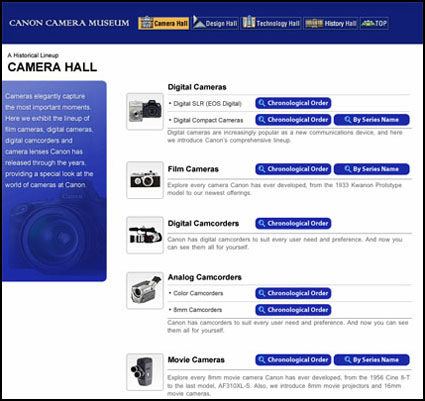
Find out about Canon camera design on the Canon Camera Museum.
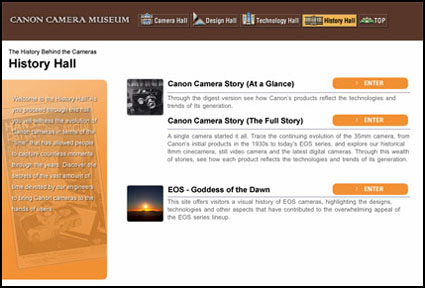
Learn about the history of Canon cameras on the Canon Camera Museum.
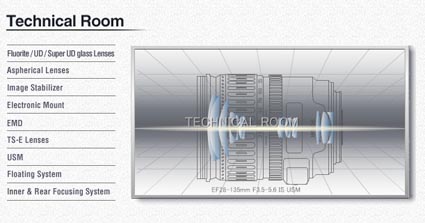
Learn about lens technology at Canon Camera Museum’s Technical Room.
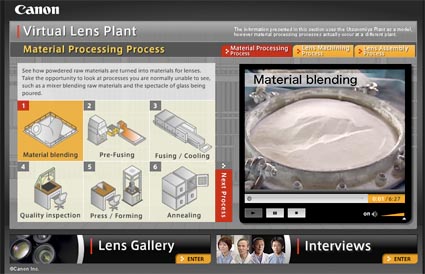
Find out how Canon lenses are made at the online Canon Camera Museum.
Prepare to be amazed! Click here.
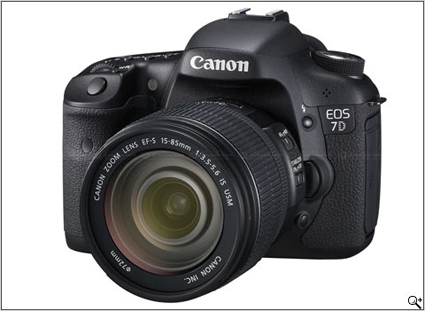
Canon introduces the EOS 7D
On September 1’st Canon unveiled their new EOS 7D digital SLR, which incorporates a new design, 18 MP APS-C CMOS Sensor (1.6x), Dual “DIGIC 4” processors, an ISO range expandable to 12,800, and continuous shooting at 8 frames per second. Oh and yea, it also shoots full HD video with options for 24 fps!
7D Features:
• 18MP APS-C CMOS sensor
• 8 frames per second continuous shooting
• 1080p HD video recording with manual controls
• 3.0 inch Clear View II LCD screen with 920,000 dots
• 19-point AF system (all cross-type)
• 1.0x magnification and 100% coverage viewfinder
• Wireless flash control
• Environmental sealing
Price:
$1,699- Body only
Is the 7D right for you?
Consider these questions:
Do I need a full frame sensor?
What kind of weather conditions so I shoot in?
Do I plan on shooting video?
How significant an upgrade is this from my current camera?
What is my budget?
Find more information about the 7D here.
Find the entire Canon line here.

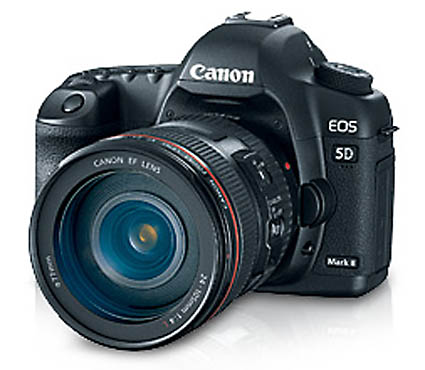
I’m loving my new Canon 5DmkII.
I asked Steven Inglima (Explorers of Light – Professional Products Marketing Division) about the new Canon 5DmkII
JP We all know the 5DmkII is an awesome 21mp DSLR capable of shooting HD video. Tell us a few other amazing things most people don’t know about the 5DmkII.
SI Here are three things.
1 – The 5DmkII has a very wide range of ISO settings and excellent exposure latitude in the Raw data. With the custom function ISO expansion engaged, the camera’s settings allow for a low ISO of 50 for extra
exposure control, and up to ISO 25,600 for the ability to shoot in near darkness.
2 – Live view mode offers the ability for very accurate focusing in critical shooting, particularly with specialty lenses like the Tilt-Shift type. When using a the Tilt feature of these lenses, obtaining very accurate focusing
on a plane not parallel to the imaging plane has always been a challenge… until the advent of live view. Now, particularly because of the 5x and 10x magnification possibilities on screen using live view, it’s easy to review
perfect focus with the lens’ tilt feature engaged, as what’s being viewed is the actual feed from the sensor itself.
3 – The LCD monitor on the rear of the 5DmkII is a very generous 920,000 pixels for an excellent review experience.
Here’s a quick roundup of Canon 5DmkII features.
21.6 mp – 5616×3477 pixels – 18.72″x12.48″ at 300 ppi
14-bit – 16,383 tones per channel
Highlight Tone Priority – adds one stop to the highlights
DIGIC IV processor for increased speed
3.9 frames per second
16-19 Raw frame bursts
310 continuous JPEG frames
New AF modes – Quick Mode, Lens Mode, Face Detect
Live Mode rear display
920,000 pixel display
ISO 50 – 25,600
Self-cleaning sensor and dust delete function
HD video (1920×1080 pixels) at 30 frames per second
Priced under $3,000
Find out more at Canon.
Find it in my Astore.

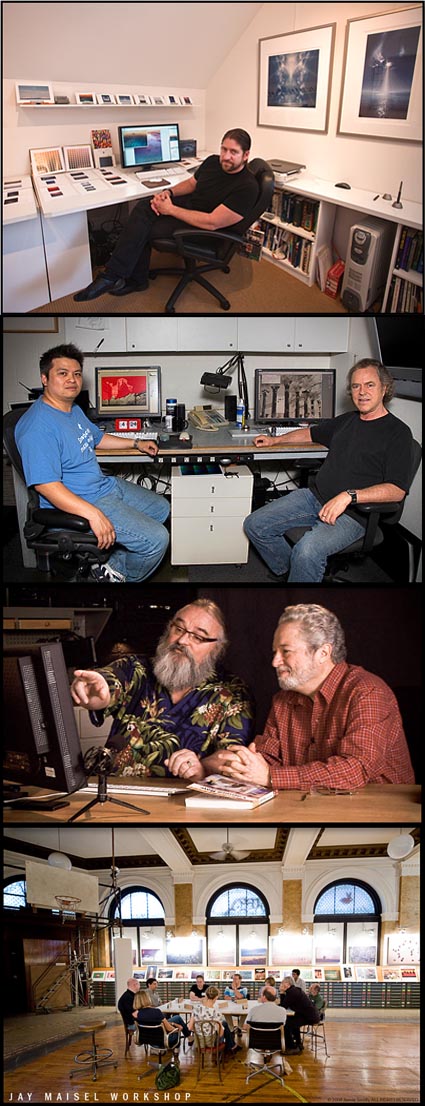
–
Who else uses NEC monitors? These guys – Schewe, Holbert, and Maisel.
These guys also use NEC – Holbert, Schewe, and Maisel.
In 1989 when we started Nash Editions … there was no expectation that the screen would accurately represent how the image would translate to paper but it did provide direct control over our output.
With the release of Colorsync in 1993 color management slowly became more and more accurate. By 2000 we were working on calibrated CRT’s that provided us with a nominally accurate representation of our printed images. Finally in 2003 we acquired 2 Sony Artisan CRT’s and we experienced an unmatched level of on-screen accuracy. As the Artisans neared their end of life we realized that replacement displays would not be CRTs. Since then we have replaced all our mission critical displays with NECs. We find that they provide us with an unparalleled level of color accuracy and angle of view. – R Mac Holbert
For the Camera Raw video tutorial, I chose to use the NEC LCD2690WUXi because it had the right combination of resolution, wide screen display, wide color gamut and yet extremely accurate profiling so I could rely upon what I saw on the display. I use it day in and day out and it’s proven trustworthy… As a visual artist, everything depends upon what I see. – Jeff Schewe
I just want the rest of the process between shooting and presenting work to be accurate and simple. That is what I like about the NEC MultiSync LCD2690WUXi monitors we use at my studio. – Jay Maisel.
Find out more about what they have to say here.
Read my conversation with Will Hollingworth (Senior Manager – Product Development for NEC) here.
See the monitors in action in my workshops.
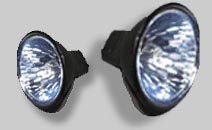
For the photographer light is important from start to finish – capture, editing, printing, and display. Solux offers products designed to give you the highest quality viewing light at surprisingly affordable rates. How much does high quality viewing light affect the way you see things? Dramatically! Recently, the Musée d’Orsay in Paris France joined the list of SoLux users that include the National Gallery of Art, the Van Gogh Museum, the Rijksmuseum, the Gugenheim and many other museums, galleries and homes. In every case they had to see it to believe it. Once they did, they’ve never looked back (or in any other light). The same thing happened to me; now I only use Solux lighting. See it and you’ll believe it too. (Check out my review and their website for more information.)
Phil Bradfield, PHD, VP-Tailored Lighting Inc. (Solux), provides a number of insightful answers about light and Solux products.
JP So, there are three things that are critical in evaluating light. Amount (lux), temperature (Kelvin degrees), and spectral distribution (smooth or spikey). Solux offers a variety of choices. Help us understand what they are and how to choose between them.
PB Excellent question JP. These are very common lighting terms that are important to understand … Read More

My Epson 9900 just arrived. I’ve been using the 7900 at the Epson Print Academy. What’s new? Incredible yellows and oranges with improved blues. The best dot structure ever, better than my 11880. Great detail and smooth gradations. Epson HDR ink isn’t a quantum leap but it is a signficant evolution.
Stay tuned for more details.
See the 7900 in action at the Epson Print Academy.
The Epson Print Academy is in Seattle tomorrow.
Henry Wilhelm will make a special appearance.